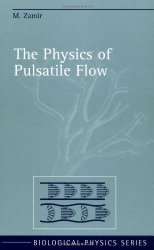Engineering Bookshelf
- Aerospace
- Biological
- Civil
- Chemical
- Environmental
- Electrical
- Materials
- Mechanical
- Petroleum
- Geoengineering
- Software

The Physics of Pulsatile Flow
Biological and Medical Physics, Biomedical Engineering
by M. Zamir, E.L. RitmanPublisher: Springer
ISBN: 0387989250
Check price @ amazon.com , amazon.ca , amazon.co.uk
Book Description
A presentation of the most elementary form of pulsatile flow as an important prerequisite for the study of other flow applications in biological systems. The book provides in a single source a complete treatment of the fluid dynamics of flow with the required mathematics and emphasis on the basis mechanics. The style and level of this book make it accessible to students and researchers in biophysics, biology, medicine, bioengineering and applied mathematics working in theoretical and clinical work on the cardiovascular system, as well as in the design of new instrumentation, medical imaging systems, and artificial organs. With problems and exercises.
Customer Reviews
By Drosos Kourounis
The Physics of Pulsatile Flow is a great introduction to the area of biofluid mechanics. Especially to those who have to solve moving boundary value problems in blood flow. It is extremely well writen so even a beginer will be able to understand fully every concept. It begins with the basic concepts & equations of fluid mechanics(Navier - Stokes, chapters 1-2)it goes on with Poiseuille flow (chapter 3), Pulsatile flowin a Rigid tube (chapter 4) and the most important chapters "Pulsatile flow in an elastic tube" (chapter 5) and "Wave reflections" (chapter 6) which has to do with waves in arterial trees. The book also presents the approach of the solution of blood flow in a rigid tube with an elliptic cross section. I didn't regreted the money I paid for it. It centerly worth it's price.
By John Li
This is a well-written book by an expert in the field of biomathmatics and cardiovascular dynamics. I am impressed by the self-contained contents of the book and the flow of thoughts. The book introduces the fundamental physical principles and fluid mechanics before embarking on the subjects of steady flow in tubes and pulsatile flow in rigid and elastic tubes. The author leads the readers smoothly into the interesting regimes of vascular tree structures and their optimization, and the wave propagation and reflection phenomena. The relevant end-of-chapter problems are good additional sources to recapture the intended message from the text, as well as learning about other applications. Students and professionals in math, science, engineering and cardiovascular dynamics will find this text a good addition to their reading list.
John K-J. Li, Ph.D.
Professor II(distinguished)
Biomedical Engineering at Rutgers
(Author of "Arterial Circulation" and
"Comparative Cardiovascular Dynamics of Mammals")